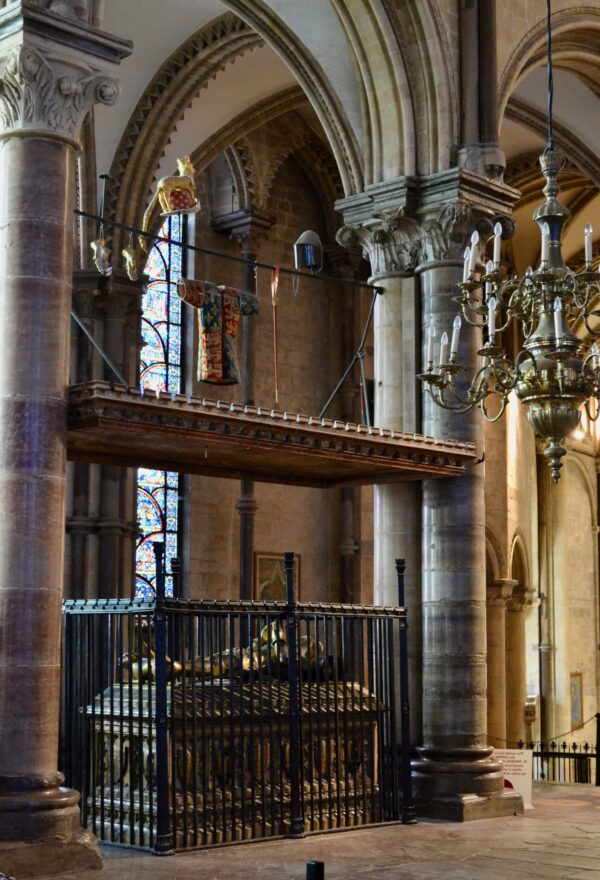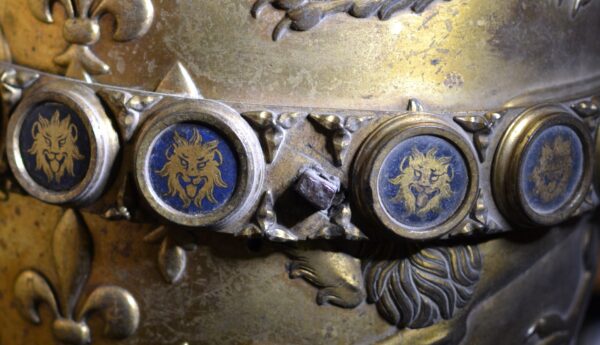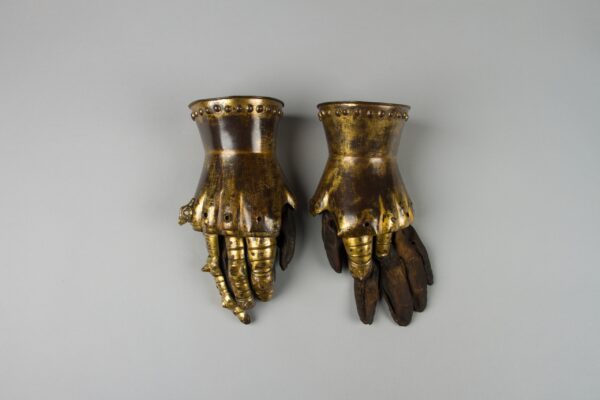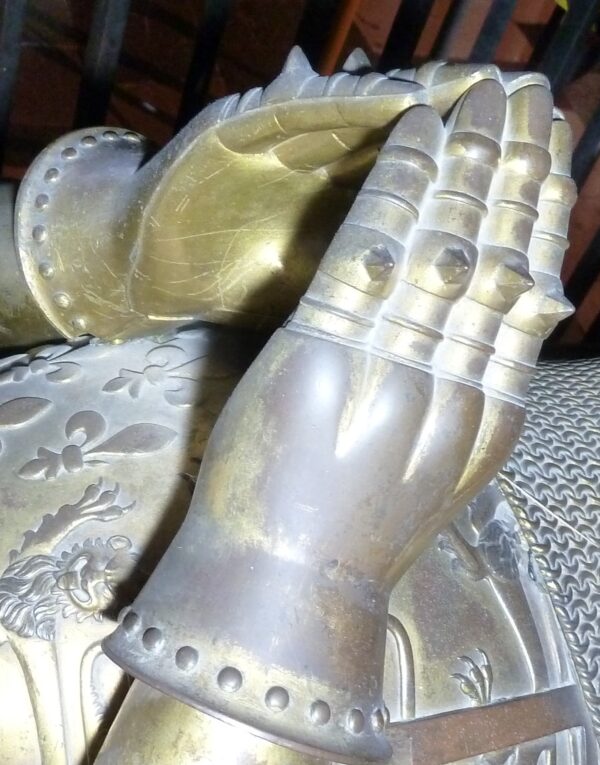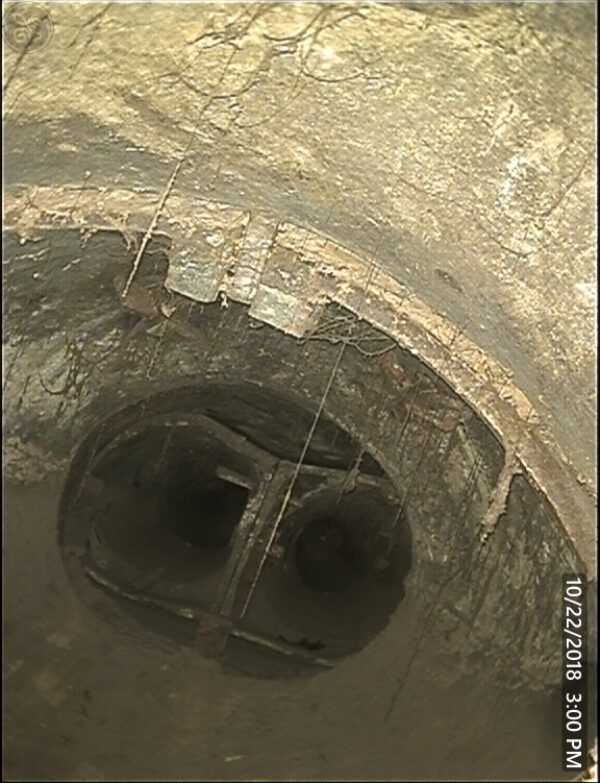A scientific analysis of the tomb of the Black Prince – the infamous medieval knight and heir apparent to the English throne – has shed new light on the ingenuity of royal artists in the 14th century.
A team of researchers, led by The Courtauld Institute of Art, used the latest scientific techniques and medical imaging technology to discover how the effigy, one of only six large-scale cast metal sculptures to survive from medieval England, was made.
The researchers conducted two studies using non-destructive methods. First, they used a handheld device that emits high-energy beams (known as a portable X-ray fluorescence spectrometer) to analyse the metal composition of the gilt effigy that lies on top of the tomb.
For the next part of their study, they inserted a videoprobe (a long tube with a light and camera, more commonly used in medical procedures) inside the hollow figure through small existing openings. This provided the first glimpse inside this sculpture for more than 600 years.
Their analysis reveals evidence that the tomb was very likely to have been ordered by Richard II, the Black Prince’s son, as much as a decade after his father’s death in 1376 as a way of buttressing the sovereignty of the Crown and countering threats against him.
It was previously thought the tomb and effigy, which can be seen in the Trinity Chapel at Canterbury Cathedral, had been made shortly after the death of the Black Prince because the design of the tomb closely follows the instructions in his will. On his deathbed, the day before he died aged 45, he set down extraordinarily detailed directions for his tomb, asking to be shown ‘fully armed’ as if for war. He demanded that his tomb was placed where everyone could see so that they would be moved to pray for “his rotting corpse”.
The team’s analysis also reveals that the effigy is one of the most sophisticated castings from the Middle Ages, cleverly constructed with the collaboration of an armourer, who both ensured the armour’s accurate detail, and helped to disguise the ways the effigy’s pieces were assembled. The new research reveals that the figure is one of a pair because of the striking similarities with the effigy of Edward III, the Black Prince’s father, at Westminster Abbey. The team believe the Black Prince’s son, Richard II, commissioned both the effigies of his father and grandfather at the same time.
Edward of Woodstock, described throughout history as the Black Prince, is thought to take his nickname either from his black armour or his brutal reputation – he is thought to have led a massacre of more than 3,000 soldiers at the Siege of Limoges in France in 1370.
He is mentioned in Shakespeare’s plays Richard II and Henry V. His key role in the Hundred Years’ War, among other events, has defined him as a contentious yet major historical figure of the Middle Ages.
Dr Jessica Barker, a senior lecturer in Medieval Art at The Courtauld, led the study with co-researcher Emily Pegues, a PhD student at The Courtauld and assistant curator of sculpture at Washington DC’s National Gallery of Art, and Graeme McArthur, a conservator at University College London. The research was carried out in collaboration with Canterbury Cathedral and has been published in the latest edition of The Burlington Magazine.
Dr Jessica Barker said: “There is something deeply affecting about the way his armour is depicted on the tomb. This isn’t just any armour— it is his armour, the same armour that hangs empty above the tomb, replicated with complete fidelity even down to tiny details like the position of rivets.
“Until now though, a lack of documents about the Black Prince’s tomb and effigy has limited our understanding of their construction, chronology and patronage so our scientific study of them offers a long-overdue opportunity to reassess the effigy as one of the country’s most precious medieval sculptures.
“By using the latest scientific technology and closely examining the effigy, we have discovered so much more about how it was cast, assembled and finished.
“We have tended to assume that the tomb and effigy were made shortly after the Black Prince died, on the instructions in his will. It now seems very likely that the Black Prince’s son, Richard II, ordered the tomb and effigy and we are able to re-date the work to a decade after the Black Prince’s death.
“It is very likely that Richard II was seeking to promote the enduring and immutable character of the Crown through the making of precious metal effigies of his father and grandfather, similar to those he would later order for himself and his wife, Queen Anne of Bohemia.”
The scientific analysis also reveals that the effigy was made by a team that unusually included an armourer and was based in part on the Black Prince’s own battle armour, which famously hangs above the tomb.
Emily Pegues said: “Although the names of the artists are lost to history, by looking very closely at how the sculpture was made, we have reconstructed the artistic processes, background and training of the artists, and even the order in which the sculpture’s many pieces were assembled.”
“This is a completely unique and innovative figure, and shows, contrary to widespread popular belief, how extremely technologically sophisticated the medieval period was.”
“It was thrilling to be able to see the inside of the sculpture with the endoscope: we found bolts and pins holding the figure together which show it put together like puzzle pieces, revealing evidence of the stages of its making which no one had seen since the 1380s.
“Portable technologies and interdisciplinary technical studies like this allow scientists and art historians to collaboratively find answers to questions which we couldn’t necessarily answer alone. We see different things.”

